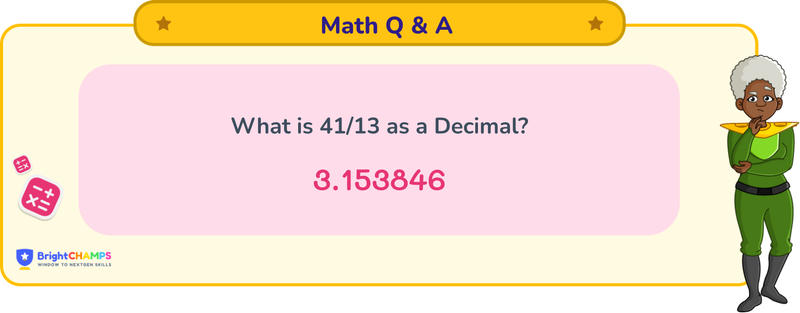
 177 Learners
177 LearnersLast updated on 5 August 2025

41/13 as a Decimal

It is a simple question on decimal conversion. Firstly, we have to learn fractions and decimals. A fraction represents a part of a whole. It has two parts: the numerator (number on the top), here 41 represents how many parts out of the whole. The denominator (number below) shows how many parts make the whole, here it is 13. A decimal is a way to represent a number that is not whole, using a (.) or a decimal to separate the whole part from the fractional part. The numbers to the left of the decimal point represent the whole, and those to the right represent the fractional part.
What is 41/13 as a decimal?

Answer
41/13 in decimals can be written as 3.153846153846.... It is a recurring decimal, indicating it will repeat the same sequence of digits infinitely.
Explanation
To get 41/13 in decimal form, we will use the division method. Here, as 41 is greater than 13, we can directly divide. Let's see the step-by-step breakdown of the process:
Step 1: Identify the numerator and denominator because the numerator (41) will be taken as the dividend and the denominator (13) will be taken as the divisor.
Step 2: Divide 41 by 13. 13 goes into 41 three times. Write 3 in the quotient place.
Step 3: Multiply 3 by 13 to get 39. Subtract 39 from 41, giving a remainder of 2.
Step 4: Bring down a 0, making it 20. Divide 20 by 13. 13 goes into 20 once. Write 1 in the quotient.
Step 5: Multiply 1 by 13 to get 13. Subtract 13 from 20, giving a remainder of 7.
Step 6: Bring down a 0, making it 70. Divide 70 by 13. 13 goes into 70 five times. Write 5 in the quotient.
Step 7: Continue this process. The sequence 153846 will repeat indefinitely.
The answer for 41/13 as a decimal is 3.153846153846....
Important Glossaries for 41/13 as a decimal
- Fraction: A numerical quantity that is not a whole number, representing a part of a whole.
- Decimal: A number that uses the base ten and includes a decimal point to separate the whole part from the fractional part.
- Numerator: The top part of a fraction, indicating how many parts of the whole are being considered.
- Denominator: The bottom part of a fraction, showing how many parts make up a whole.
- Recurring Decimal: A decimal in which a sequence of digits repeats infinitely.




